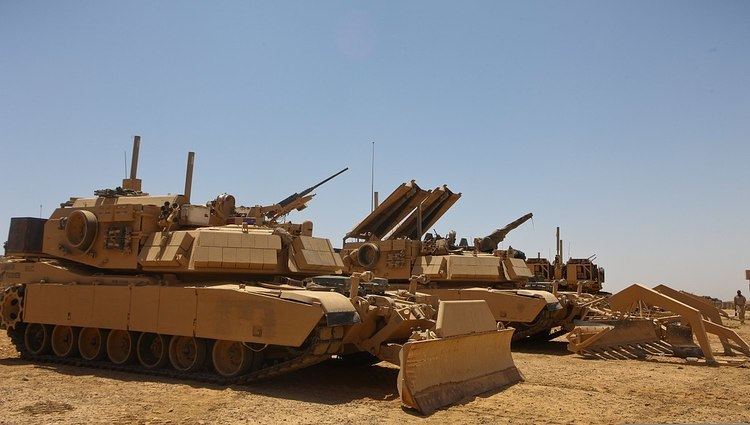Place of origin United States Wars War in Afghanistan | In service 2010–present Number built 39 | |
 | ||
Type Military Engineering Vehicle Used by United States Army, United States Marine Corps | ||
M1 Assault Breacher Vehicle (ABV), nicknamed The Shredder, is a U.S. military mine- and explosives-clearing vehicle, based on the M1 Abrams-chassis, equipped with a mine-plough and line charges. Its first large scale use by the US Marines was in the joint ISAF-Afghan Operation Moshtarak in Southern Afghanistan during the War in Afghanistan in 2010 against the Taliban insurgency.
Contents
Design and purpose
These tracked combat vehicles were especially designed to clear pathways for troops and other vehicles through minefields and along roadside bombs and improvised explosive devices. The 72-ton, 12 m (40 foot) long vehicles are based on the M1 Abrams with a 1,500 horsepower engine, but fitted with a 12.7 mm machine gun and a front-mounted 4.5 m (15-foot) wide plow, supported by metallic skis that glide on the dirt and armed with nearly 3,175 kg (7,000 lb) of explosives.
They were called "the answer" to the deadliest threat facing NATO troops in this conflict. The Breachers are also equipped with M58 MICLIC Mine Clearing Line Charges: rockets carrying C-4 explosives up to 100–150 yards forward, detonating hidden bombs at a safe distance, so that troops and vehicles can pass through safely.
In the 1990s, the U.S. Army decided it could not afford to continue developing complicated, maintenance-heavy vehicles for this purpose. The Grizzly program was canceled in 2001, and the prototype developed never made it to the production lines. The Marine Corps however persisted and funded its own development and testing. The main body of the final model of the ABV is built on the General Dynamics chassis that is used for the M1A1 Abrams Main Battle Tank. Pearson Engineering of the UK provided the specially designed plow and the other mine-clearing accessories.
First use in combat
In the morning of December 3, 2009, for the first time breachers were used in combat, when Marines pushed into the Taliban stronghold Now Zad during Operation Cobra's Anger in Helmand province, on their way to another Taliban stronghold Marjah, 380 miles (610 kilometers) southwest of Kabul, that was to be assaulted in February 2010.
On February 11, 2010, two breachers fired explosive line charges in the desert outside Sistani, to test Taliban defenses on the eve of Operation Moshtarak when closing off the enemy's escape route.
On February 13, 2010, on the first day of the operation, breachers of the US Marines 2nd Combat Engineer Battalion succeeded in digging and blasting "safety lanes" through the numerous minefields laid by the Taliban around Marjah.
According to a report in December 2009, there were then five ABVs in Afghanistan, and the U.S. Marines were said to have plans to field a total of 52 by 2012, of which about 34 have already had been produced. The U.S. Army was said to have ordered 187.
Other deployments
By August 2013, six Assault Breacher Vehicles were brought to the Korean Peninsula. They are used by the 2nd Infantry Division to provide the capability for deliberate and in-stride breaching of mine fields and complex obstacles. The ABVs would allow the 2ID to clear the heavily mined Korean Demilitarized Zone, believed to contain tens of thousands to millions of mines. A previous deployment of MRAP mine-resistant vehicles to Korea caused North Korea to accuse their presence as vehicles that would cross the DMZ for an attack of the country; the MRAPs were later withdrawn due to their unsuitability for the terrain. North Korea did not respond to the ABV's arrival to the peninsula.
